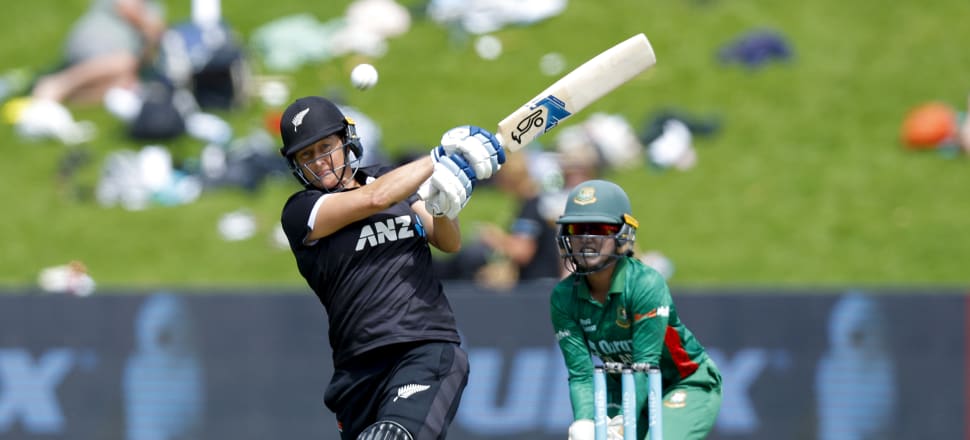
Six years on from the report revealing the dire state of women's cricket in NZ, an update shows the game to be much healthier - but with still much work to do to achieve equity, Suzanne McFadden writes.
Sarah Beaman is relieved. It’s six years since she released her Women and Cricket report into the bleak state of the game in New Zealand, when she feared female cricket was dying.
“What I discovered was women having virtually no voice in the governance or leadership of cricket, few women coaching or umpiring, and female players a species on the verge of extinction,” she wrote at the time.
But she’s now seen the work New Zealand Cricket have done to address the 17 areas of concern she highlighted, brought on by 'decades of under-investment and neglect', and she’s satisfied women’s cricket is now well on the path to gender equity in the sport.
“You can do a review for an organisation, and they can accept it, and then things don’t really change too much,” says Beaman, a former New Zealand U23 captain and now a professional business consultant. “But it’s been really interesting seeing what has been done, the progress across all areas, because a lot of it hasn’t been that visible.”
The update on the 2016 report shows all 17 of Beaman’s recommendations have received attention, but none of the problem areas have been completely resolved. It’s a work in progress, says New Zealand Cricket’s network transformation lead, Nicole Dunn.
READ MORE: * Inventive Frankie takes waterslide to cricket pitch * New head of women's cricket far from Green
“There’s no end point with this; there’s not a destination. Women’s cricket will be a continual focus for us,” she says.
But the next six months will be critical – to build on the success of the Cricket World Cup played in New Zealand last summer, and draw back the girls who couldn’t play when programmes were cancelled by Covid.

There are some heartening statistics in the update.
- Women on boards within NZ cricket has risen from six percent to 38 percent.
- In 2016, only 42 percent of clubs offered cricket for girls and women; now 81 percent of clubs do.
- The number of female cricketers grew from 31,800 to 43,600 in 202021 (but dropped dramatically to 25,000 last season when Covid severely impacted cricket programmes)
- The number of female coaches has increased 19 percent
- Social media following for the White Ferns jumped from 64,000 to 194,000 fans
But there’s no argument there’s still a lot of work to do until there’s gender equity across the board in cricket, and girls and women want to stick with, or return to, the game – as players, coaches, officials or directors.
“It’s tough making change at the grassroot level,” Beaman says. “A lot of the gender diversity inclusion stuff is a societal shift for people.
“So it’s been cool for me to see they’re on the journey. Even if they’ve still got a long way to go. I certainly see cricket further along the journey than a lot of other sports are.”

The drive to have more women in decision-making roles on cricket boards around the country has seen one of the biggest shifts in the last six years. Lifting the proportion of females in cricket governance was Beaman’s first recommendation and she’s since been involved in helping drive the change.
NZ Cricket introduced their Women in Cricket Governance project in 2017, and the following year a target was set for every board in the country, right down to district associations, to have at least two female directors by the end of 2019. That changed to 40 percent (in line with the Sport New Zealand mandate) at the end of last year.
There was initially some resistance to a “quota”, but the number of female directors throughout the country has leapt from 11 women in 2016 to 82 today. The NZ Cricket board have four women among their eight directors, as well as a new female president, Lesley Murdoch. (Beaman joined the NZC board last month).
Some district associations still lag behind – of their 161 directors, just 56 are females (35 percent).
“It’s been extremely successful at a national and major association level, and now it’s filtering down to impact everything below it,” says Dunn.
Beaman didn’t expect gender equity in governance to happen quickly. “It’s really hard to change the habits of a lifetime, in experiences, perceptions and unconscious bias,” she says.
“When you have greater diversity it can be harder, because you have different opinions and the discussions are longer. It’s accepting that’s okay, and that takes skills as a chair to facilitate those often tricky decisions, but then you get to a better decision.”
Introducing the first joint Master Agreement, representing both women and men cricketers this year has gone a long way to meeting Beaman’s recommendation to value and support the White Ferns and emerging players.
The agreement provides our top women’s cricketers the same money for the same day’s work as their male counterparts for the first time in New Zealand cricket history. They also now get the same high performance training facilities, the same wraparound services and the same kit as the Black Caps.

In 2017 there were just 15 contracts for White Ferns – now there are 17 players contracted fulltime, and 72 women with domestic contracts for five months of the year.
The top-ranked White Fern can now collect around $163,000 for a season – almost double what they received under their old contracts (just as a comparison, the top-ranked Black Cap gets a maximum of $523,000). A leading domestic player now gets $19,000 – around $15,000 more than before.
White Ferns captain Sophie Devine called the agreement a 'game-changer' for women playing cricket in New Zealand: "It's a massive step forward and will be a huge drawcard for young women and girls."
The White Ferns have more visibility – the average live audience of White Ferns games grew from 31,000 in 2016 to 190,000 last summer. That will have multiplied with the Cricket World Cup coverage too, which attracted a 230 million global audience.
They're also receiving greater media attention - women's cricket coverage in New Zealand media increased 67 percent in 2021, and during the World Cup, women's sport commanded 33 percent of all sports news coverage.
But the World Cup results, where New Zealand failed to make the semifinals, also reflected how Australia and England are “reaping the benefits of having started this Women and Cricket journey ahead of us,” Beaman says.
So NZ Cricket asked women and girls how they wanted to play cricket, not just delivering it the ‘way it’s always been done’.
Participation is an area Dunn is particularly pleased to see change.
“One stat that stands out to me is the percentage of clubs who didn’t have anything for women and girls to now – it’s a real key indicator of progress being made at grassroots,” she says. In 2016, 58 percent of clubs didn’t offer cricket for girls or women (now only 19 percent don’t), and over 90 percent of clubs didn’t have any girls-only teams.
A key recommendation from the report was to ‘grow female participation in positive cricket playing experiences throughout New Zealand by targeting females connected to the cricket family’.
Dunn’s main focus in in community cricket, where junior cricket is almost 50:50 girls and boys participation. The ongoing struggle, though, is to keep players as they move into youth and senior cricket.
“We know there will always be a drop-off of teenagers. But an area we can continue to grow is providing opportunities for young females to play across New Zealand, both in a social context and the performance space. We need to keep them engaged and playing,” she says.
So NZ Cricket asked women and girls how they wanted to play cricket, not just delivering it the ‘way it’s always been done’. Yeah! Girls is part of the solution.

Created for 10-17 year old girls, the Yeah! Girls programme doesn’t have team selection, provides girls with all playing equipment, and has 60-minute modified cricket games over a six-week stint. It engaged over 3000 girls last season; 60 percent of them were new to cricket.
“It’s certainly showed us if we create initiatives that offer cricket in a way girls want to play then they actually play it,” Dunn says. “So how do we keep them involved year or year, and how are our clubs are mirroring that setting, so if the girls also want to join a club team there’s still a fun, social option too.”
Otago Cricket has come with their own answer – Girls Smash, a six-a-side game for primary school girls. Where they had just two junior girls-only teams in 2015, they now have 124 teams throughout Otago.
Cricket has done well to attract those young players, Beaman says. But she’s also concerned about how to keep them in the sport.
“It’s always been about ‘how do we get them onto the high performance pathway?’ It’s a real challenge because you want some of them on that pathway otherwise you don’t have the White Ferns,” she says. “But there are a lot who don’t want to go over there, and you lose them if you push them. That’s what’s happened in cricket in the past.
“I still had hoped that more girls would go on to club cricket, but another half of me who did all the research knows they don’t want that. So the question is how do you get both and make it sustainable?”

Beaman wants to see more former players encouraged to return to the sport. "The reality for women is that you have other stuff going on in your life, whether it's uni or having children. And that’s hard for traditional sports systems to deal with and accept it’s okay for them to play for four years, go away, then come back again. We want them to feel there are offerings for them to return as a player, a match referee or a coach," she says.
And she'd also like to see some of those former players help break down the misconception that male coaches know more than females.
“When I did the research, I interviewed current first class players and U21s, and it was 50:50 who wanted a female coach and who didn’t,” says Beaman, who’s coached the Auckland Hearts. “We want to develop female coaches, but there’s a really important societal thing going on … ‘as a female player I must need a male coach because they must know more’.
“It’s not true, it’s the best person for the job. There are a lot of female coaches who have the knowledge and experience, but I feel there’s still a barrier to aspiring coaches going along the coaching pathway.
“I feel like there are ex-players who are coaches who have the knowledge. The quickest way to shift that is to see are we doing enough to attract back those female coaches who have been associated with the game who aren’t seeing that coaching pathway.”
What the report doesn’t show is the impact this year’s Cricket World Cup – and the White Ferns’ bronze at the Commonwealth Games in August - have made on women and girls here. But Dunn says it’s been huge, in terms of the White Ferns finally becoming household names and the showcase of “powerful, athletic female cricketers”.
But are NZ Cricket concerned that interest will now have been trumped by the Black Ferns’ Rugby World Cup success last month?
“Balance is better,” Dunn says. “If girls want to play rugby that’s great, but we’d love them to play cricket in summer, too. If a young girl, or boy, is playing football in the winter, they will probably be a better cricketer in the summer.
“But it’s on us to make it a sport they want to play. It all comes down to it’s got to be fun, and be with your mates. It can still be competitive, but fun.”







